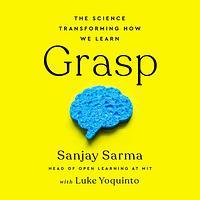Take a photo of a barcode or cover
I really wanted more neuroscience, but the history of MOOCs was cool too. Not so interested in the play-by-play of the battle bots competition.
challenging
hopeful
informative
reflective
slow-paced
informative
medium-paced
medium-paced
informative
inspiring
fast-paced
In light of how the COVID pandemic has affected education, this is a timely book about the history, psychology, and neuroscience of education, the role of modern tech-enhanced methods, as well as the future of learning.
The book is divided into 2 parts. In the first part, the author reviews the history of education, the birth of behaviourism, and the learning divide between Thorndike’s inside-out-thinking and Dewey’s outside-in-thinking. The author also delves into 4 layers of what he refers to as the “cognitive high-rise"; beginning at the molecular and cellular scale, ascending into the systems layer of brain regions, then into cognitive psychology, and finally into the upper layer of metacognition (thinking about thinking). In the second part, the author discusses applications of the science of the “cognitive high-rise” and the role of technology in education and provides extensive case studies into modern tech-enhanced approaches such as TEAL (Technology Enabled Active Learning), flipped and blended learning, 42 school of Silicon Valley, Ad Astra, AltSchool, IBM Watson, MOOCs, MITx, MicroMasters, etc.
The book offers plenty of insights into science-based approaches to learning including spacing and interleaving and their relationship with memory at all levels of the “cognitive high-rise”. It also debunks some neuromyths, examines the implications of how the brain learns on dyslexia, and explains the roles of curiosity, forgetting, and effortful retrieval in learning.
The book is rich in history and has a narrative style that blends anecdotes with personal stories and a balanced discussion of the challenges and advantages and disadvantages of the various approaches to learning. I took one star from my rating because it can sometimes be long-winded and taxing to read as the author tends to recount mundane details. Nevertheless, I highly recommend it to readers interested in learning science and the history and future of education.
The book is divided into 2 parts. In the first part, the author reviews the history of education, the birth of behaviourism, and the learning divide between Thorndike’s inside-out-thinking and Dewey’s outside-in-thinking. The author also delves into 4 layers of what he refers to as the “cognitive high-rise"; beginning at the molecular and cellular scale, ascending into the systems layer of brain regions, then into cognitive psychology, and finally into the upper layer of metacognition (thinking about thinking). In the second part, the author discusses applications of the science of the “cognitive high-rise” and the role of technology in education and provides extensive case studies into modern tech-enhanced approaches such as TEAL (Technology Enabled Active Learning), flipped and blended learning, 42 school of Silicon Valley, Ad Astra, AltSchool, IBM Watson, MOOCs, MITx, MicroMasters, etc.
The book offers plenty of insights into science-based approaches to learning including spacing and interleaving and their relationship with memory at all levels of the “cognitive high-rise”. It also debunks some neuromyths, examines the implications of how the brain learns on dyslexia, and explains the roles of curiosity, forgetting, and effortful retrieval in learning.
The book is rich in history and has a narrative style that blends anecdotes with personal stories and a balanced discussion of the challenges and advantages and disadvantages of the various approaches to learning. I took one star from my rating because it can sometimes be long-winded and taxing to read as the author tends to recount mundane details. Nevertheless, I highly recommend it to readers interested in learning science and the history and future of education.
This was a great book for anyone interested in the topic of learning and how we learn. Sanjay Sarma is the head of Open Learning at MIT, which is the department that allows anyone to check out courses from MIT. The book does a fantastic job discussing the misconceptions about learning, the bad practices educators get into when it comes to teaching people, and it also discusses how the underprivileged are left behind.
The book got a little slow for me at some points, so this one took me a while to read. Overall, I learned a ton from it, and as someone who continues to try and learn new things, I definitely got some helpful tips.
The book got a little slow for me at some points, so this one took me a while to read. Overall, I learned a ton from it, and as someone who continues to try and learn new things, I definitely got some helpful tips.
As chalk full of information as this book was, at points I found myself lost in all of it. The transitions between each subject were good, but it felt like information was moving too fast. I liked knowing the history behind why schools and universities are set up the way they are, but it felt like the book was still grasping at its own purpose. I think some graphics or illustrations of what the author was talking about would have been helpful to better depict things. Other than that, I would definitely recommend this to those who are interested in how we've learned as technology as progressed and what we can do to try and change it.
Good read if you like psychology, bits of neuroscience, and education.
reflective
slow-paced



